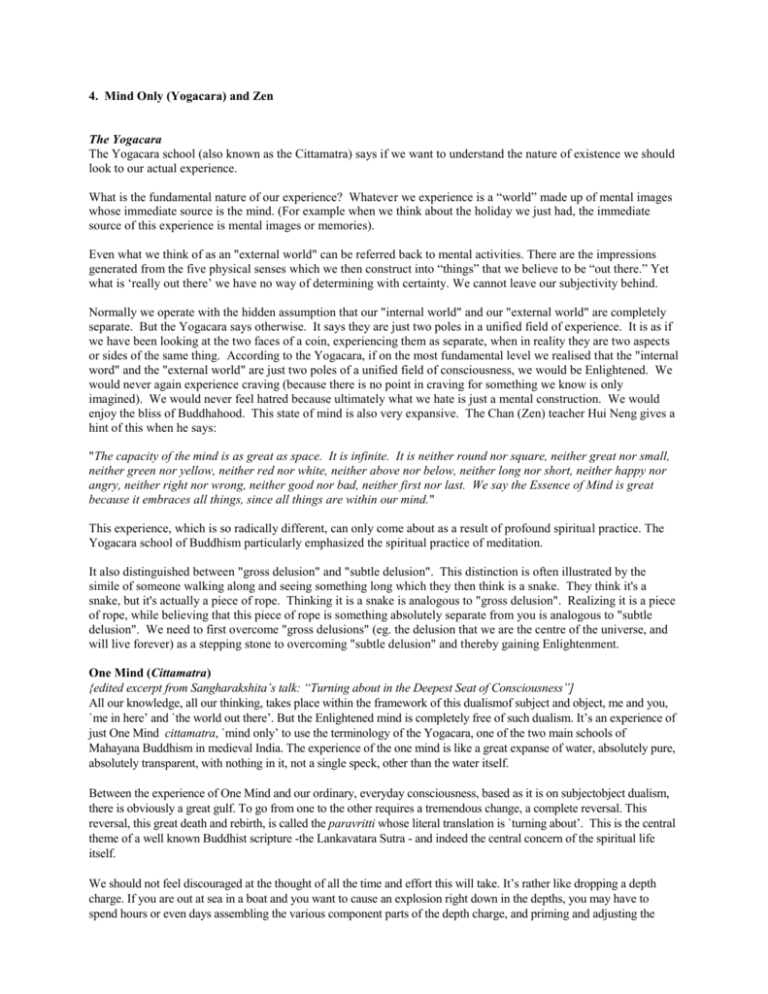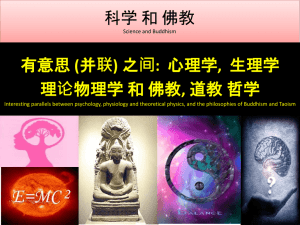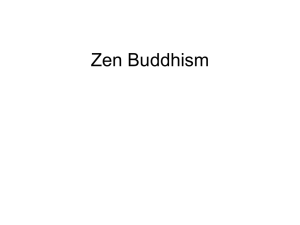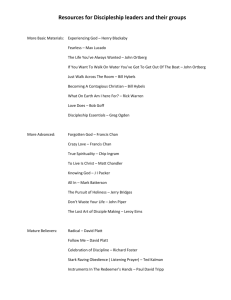(Yogacara) and Zen - Triratna Centre Support
advertisement

4. Mind Only (Yogacara) and Zen
The Yogacara
The Yogacara school (also known as the Cittamatra) says if we want to understand the nature of existence we should
look to our actual experience.
What is the fundamental nature of our experience? Whatever we experience is a “world” made up of mental images
whose immediate source is the mind. (For example when we think about the holiday we just had, the immediate
source of this experience is mental images or memories).
Even what we think of as an "external world" can be referred back to mental activities. There are the impressions
generated from the five physical senses which we then construct into “things” that we believe to be “out there.” Yet
what is ‘really out there’ we have no way of determining with certainty. We cannot leave our subjectivity behind.
Normally we operate with the hidden assumption that our "internal world" and our "external world" are completely
separate. But the Yogacara says otherwise. It says they are just two poles in a unified field of experience. It is as if
we have been looking at the two faces of a coin, experiencing them as separate, when in reality they are two aspects
or sides of the same thing. According to the Yogacara, if on the most fundamental level we realised that the "internal
word" and the "external world" are just two poles of a unified field of consciousness, we would be Enlightened. We
would never again experience craving (because there is no point in craving for something we know is only
imagined). We would never feel hatred because ultimately what we hate is just a mental construction. We would
enjoy the bliss of Buddhahood. This state of mind is also very expansive. The Chan (Zen) teacher Hui Neng gives a
hint of this when he says:
"The capacity of the mind is as great as space. It is infinite. It is neither round nor square, neither great nor small,
neither green nor yellow, neither red nor white, neither above nor below, neither long nor short, neither happy nor
angry, neither right nor wrong, neither good nor bad, neither first nor last. We say the Essence of Mind is great
because it embraces all things, since all things are within our mind."
This experience, which is so radically different, can only come about as a result of profound spiritual practice. The
Yogacara school of Buddhism particularly emphasized the spiritual practice of meditation.
It also distinguished between "gross delusion" and "subtle delusion". This distinction is often illustrated by the
simile of someone walking along and seeing something long which they then think is a snake. They think it's a
snake, but it's actually a piece of rope. Thinking it is a snake is analogous to "gross delusion". Realizing it is a piece
of rope, while believing that this piece of rope is something absolutely separate from you is analogous to "subtle
delusion". We need to first overcome "gross delusions" (eg. the delusion that we are the centre of the universe, and
will live forever) as a stepping stone to overcoming "subtle delusion" and thereby gaining Enlightenment.
One Mind (Cittamatra)
{edited excerpt from Sangharakshita’s talk: “Turning about in the Deepest Seat of Consciousness”]
All our knowledge, all our thinking, takes place within the framework of this dualismof subject and object, me and you,
`me in here’ and `the world out there’. But the Enlightened mind is completely free of such dualism. It’s an experience of
just One Mind cittamatra, `mind only’ to use the terminology of the Yogacara, one of the two main schools of
Mahayana Buddhism in medieval India. The experience of the one mind is like a great expanse of water, absolutely pure,
absolutely transparent, with nothing in it, not a single speck, other than the water itself.
Between the experience of One Mind and our ordinary, everyday consciousness, based as it is on subjectobject dualism,
there is obviously a great gulf. To go from one to the other requires a tremendous change, a complete reversal. This
reversal, this great death and rebirth, is called the paravritti whose literal translation is `turning about’. This is the central
theme of a well known Buddhist scripture -the Lankavatara Sutra - and indeed the central concern of the spiritual life
itself.
We should not feel discouraged at the thought of all the time and effort this will take. It’s rather like dropping a depth
charge. If you are out at sea in a boat and you want to cause an explosion right down in the depths, you may have to
spend hours or even days assembling the various component parts of the depth charge, and priming and adjusting the
mechanism. And you do all that on the deck, even though you want to produce an effect many fathoms below. It’s no use
getting impatient and thinking: `Why waste all this time putting it all together here on deck? Why not just throw the stuff
overboard and hope for the best?’ Spiritual practice is rather like that. It is easy to get discouraged, and think: `I’ve been
meditating (or doing some other practice) for all these weeks and months and years, but I’m still not close to
Enlightenment. Even when we feel we’re not getting anywhere, the important thing is to carry on, because all this work
has to be done at the level of the ordinary consciousness in order to produce the required result at the level of absolute
mind.
Chan (Zen) Buddhism
This form of Buddhism arose in China, originally out of the Yogacara school of Mahayana Buddhism, (although
according to myth it goes directly back to the historical Buddha in a series of one-to-one teacher-to-student
transmissions). Chan arose as a distinctively Chinese genre of Buddhism. Previously Buddhism had mainly been
expressed in the context of Indian culture. Like the Yogacara from which it arose, Chan placed a lot of emphasis on
meditation. Quite early on Chan also incorporated many elements of the Madyamaka school of Buddhism (studied
three weeks ago). Later on Chan spread from China to countries such as Vietnam, Korea and Japan. Although Chan
(which in Japan is known as Zen) is a big subject, the following lecture excerpt should give you an initial taste.
The nature of Chan (Zen) Buddhism changed over the centuries, and as it spread to new areas. In the time of Hui
Neng (631 - 713) Chan was still at a nascent stage. There were no koans (existential riddles) or large halls of people
meditating together. At that stage art forms such as Chinese brush painting were not thought of as characteristically
Chan. The main Chan practices in Hui Neng's day seems to have been meditation and recitation of sacred scriptures.
Myth of the foundation of Chan
It is said that one day the Buddha was sitting in a jungle clearing in the midst of a great concourse of his disciples, all
completely silent. The Buddha said nothing, but eventually, in the midst of the silence, he lifted up a golden flower. All
the disciples saw it, they all looked at it, but only one understood the meaning, and that was Mahakasyapa. He
understood and just smiled. So the Buddha then said, "O Mahakasyapa, I now transmit my Dharma (my doctrine) to
you." This, according to this myth, was the origin of Chan, and was followed by an unbroken lineage of one-to-one
transmissions from Mahakasyapa through to Chinese Chan masters.
Although historical evidence demonstrates that there was no such lineage of one-to-one transmissions the story has its
value.
Chan (Zen) poetry
Chan has always been renowned for its great poets and unique way of expressing the nature of realization. Here are
a few examples:
My daily activities are not unusual,
I'm just naturally in harmony with them.
Grasping nothing, discarding nothing...
Supernatural power and marvelous activity Drawing water and carrying firewood.
- Pang-yun (740-808)
Unfettered at last, a traveling monk,
I pass the old Zen barrier.
Mine is a traceless stream-and-cloud life,
Of these mountains, which shall be my home?
- Manan (1591-1654)
To what shall I compare this life of ours?
Even before I can say
it is like a lightning flash or a dewdrop
it is no more.
- Sengai
Before I had studied Chan for thirty years, I saw mountains as mountains,
and waters as waters.
When I arrived at a more intimate knowledge, I came to the point
where I saw that mountains are not mountains,
and waters are not waters.
But now that I have got its very substance I am at rest.
For it's just that I see mountains once again as mountains,
and waters once again as waters.
- Ching-yuan
Buddha preached in the twelve divisions,
each division full of purest truth.
East wind -- rain comes in the night,
making all the forest fresh and new.
No sutra that does not save the living,
no branch in the forest not visited by spring.
Learn to understand the meaning in them,
don't try to decide which is "valid," which is not.
- Ryokan, 1758-1851
The world? Moonlit
Drops shaken
From the crane's bill.
- Dogen
When the mind is at peace,
the world too is at peace.
Nothing real, nothing absent.
Not holding on to reality,
not getting stuck in the void,
you are neither holy or wise, just
an ordinary fellow who has completed his work.
- Pang-yun (740-808)








